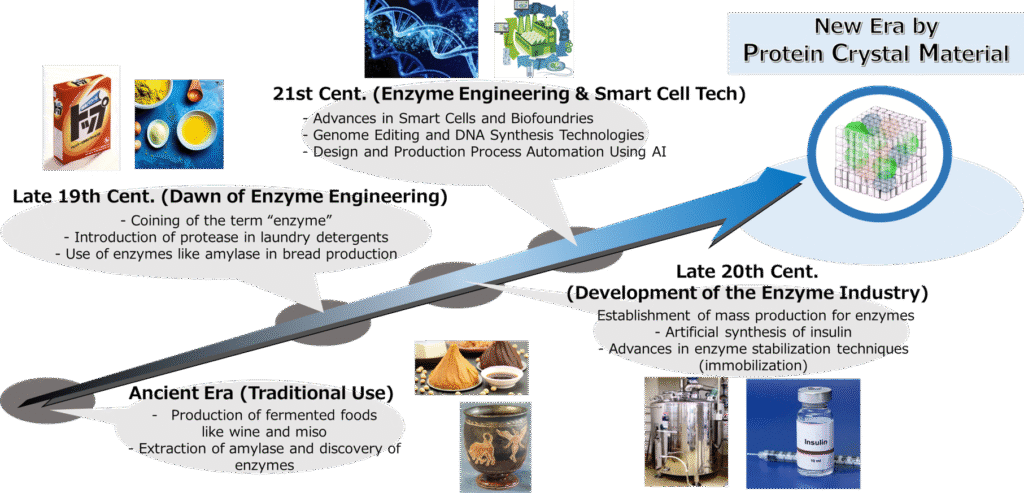Enzymes encapsulated within PCM retain their structural integrity and catalytic activity in organic solvent environments, allowing efficient biotransformations under non-aqueous conditions and expanding substrate compatibility.
Technology
What Are Protein Crystals?
Protein crystallization is the process by which biomolecules arrange themselves into highly ordered, microscopic lattice structures. Since its first description in the mid-19th century, this technique has underpinned advances in structural biology and pharmaceutical manufacturing—enabling the industrial production of insulin, enzyme therapeutics, and more. Today, crystallization is valued not only for revealing molecular structures but also as the launchpad for designing next-generation high-performance biomaterials.

酵素の産業利用の歴史
What Is Protein Crystal Material (PCM)?
Protein Crystal Material (PCM) is a technology that leverages proteins capable of crystallizing inside cells to encapsulate target proteins within a protective crystal matrix, shielding them from external stresses such as dehydration, high temperature, and pH changes. By directly harnessing the spontaneously formed in-cell crystals of the target protein as a functional biomaterial, PCM streamlines the entire workflow—from gene design and cell cultivation to cell disruption—within living cells, efficiently yielding high-purity, shape-controlled crystal particles. PCM’s exceptional robustness and programmability open up diverse applications, including biocatalysis and biosensing.

Advantages of PCM
① Eliminates The Need for Complex Purification Processes
By encapsulating target enzymes at high density within PCM inside the cell, then extracting and gradually releasing them, you can obtain the desired product in a physically stable, high-purity form. This “in-cell purification of enzymes” eliminates the need for complex, high-cost downstream purification steps—such as chromatography—that are indispensable in conventional processes. It can reduce purification time by approximately 80% compared to conventional processes.
② Dramatically Enhanced Shelf Stability
PCM is exceptionally robust against environmental stresses—such as high temperature, desiccation, pH fluctuations, and high salinity—enabling enzymes that were previously difficult to preserve to achieve vastly extended shelf life.
③ Suppresses Enzyme Cytotoxicity
④ Enables Catalysis in Organic Solvents
By encapsulating target enzymes within PCM, their native structure and activity are preserved even in organic solvents that normally denature proteins, allowing efficient biocatalysis of hydrophobic substrates under non-aqueous conditions.
⑤ Enables Multi-Enzyme Cascade Reactions
Multiple target enzymes can be co-encapsulated within a single PCM, enabling one-pot cascade reactions where sequential enzymes work together and significantly enhance overall reaction efficiency.
⑥ Enables Cofactor Regeneration Systems
Both the cofactor and its regeneration enzyme can be co-encapsulated within a single PCM, eliminating the need for repeated addition of costly cofactors.

